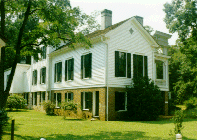
|
|
"Defend yourselves, the enemy is at your door ... !" thundered Robert Toombs from the Senate floor on January 24, 1860. It was a turning point in history. Rejecting moderation, Toombs would use his influence to lead Georgia to secession and the war. The story of Toombs' participation in the events of the Civil War is told in exhibits at his restored and furnished home.
A successful planter and lawyer, Toombs led a turbulent career as state legislator, U. S. congressman and senator. With ambitions of becoming president of the confederacy, he resented Jefferson Davis' election. Toombs reluctantly accepted appointment as Secretary of State before resigning to take a commission in the Army of Northern Virginia. When his Napoleonic ambitions were frustrated, the embittered General Toombs resigned and spent the remainder of the war years in Washington, Georgia, brooding and criticizing the Confederate government.
Escaping from Federal Troops sent to his house to arrest him, Toombs spent the next two years in hiding and exile abroad. Upon returning to America, Toombs scorned the thought of accepting political pardon. In 1880 he boasted, "I am not loyal to the existing government of the United States and do not wish to be suspected of loyalty.
The main body, a two-story structure on a high basement, was built in 1794 by Dr. Joel Abbott, who came here from Connecticut. Abbott was first employed by the state as a medical representative in setting up the United States dispensary and later was a member of Congress from 1817 to 1825.
The Doric colonnade and western wing were built by General Toombs after he purchased the house in 1837; the eastern wing was built by him after the Civil War.
Massive cast-iron chandeliers brought from Toombs' home in Washington, D.C., when the Confederate States seceded and Toombs left his post in the Senate were lighted with gas from Toombs' private plant, the first gasworks in the town.
Robert Toombs, the unreconstructed rebel
Robert Toombs, born in Wilkes County in 1810, was a powerful and robust personality, one of the most dramatic figures in Georgia history. He attended the University of Georgia and Union College at Schenectady, New York, later studying law at the University of Virginia. He amassed a fortune through his law practice, and easily won any political office in Wilkes County that he sought. During his service in the State Legislature (1837-43), Toombs helped establish the State Supreme Court. He entered Congress in 1845, and in 1853 was elected to the United States Senate.
His farewell speech, January 7, 1861, has been celebrated as a masterpiece on secession. He resigned his position as Secretary of State in Davis' Confederate cabinet, because he believed he could render more valuable service on the battlefield. As a brigadier general, he was wounded in Antietam in 1862. He gave up his commission but later was in active service as divisional adjutant and inspector-general of the Georgia Militia during Sherman's Atlanta campaign.
By the end of the war Toombs was at home. Soon after the members of the Confederate Cabinet had left Washington, a man on horseback rode up to the Toombs House, threw a bag containing five thousand dollars in specie over the fence, and hurriedly galloped away. There was no message with the money, but the inference was that it was to aid the general to flee from Union soliders who had been ordered to arrest the former Confederate officials. Toombs, however, thought that the money was part of the funds belonging to the pilfered Confederate treasure and ordered it to be paid to the returning soliders.
A majestic oak in front of the house sheltered Federal soliders who came here in 1865 to arrest Toombs, and from the point soldiers marched down the street with his picture stuck on the point of a bayonet so that he might be recognized and captured on sight. The general was in his office when the men came, but while his wife kept them occupied he quickly escaped by the back way to the servants' quarters, where he mounted his mare Gray Alice and rode away. It is told that he was hidden in Columbus by Augusta J. Evans, later to become known as the author of St. Elmo and other popular romances. Toombs escaped to Havana by way of New Orleans. After his flight the Federal soldiers wanted to burn down the house, believing he might be hidden there, but Mrs. Toombs sent for the fearless Baptist preacher Henry Allen Tupper, who convinced them that Toombs had escaped. After the flight, Toombs' wife and daughter were ordered to leave the house but were later permitted to return. Mrs. Toombs joined her husband in Cuba, and the two left for England. He lived in England and Europe before returning, "an unpardoned rebel" as he liked to be called, to his native town.
As long as Toombs lived, he kept open house, and rarely was a meal served without guests. He once opposed a movement to build a hotel in the city, because, "If a respectable man comes to town, he can stay at my house. If he isn't respectable, we don't want him here at all."
Related Article: The Story Behind Two Great Oaks Named for Robert Toombs
Location
216 East Robert Toombs Avenue
Washington, Georgia 30673
(706) 678-2226
Hours
Tues. - Sat. 9-5, Sun. 2-5
Closed on Mondays (except on some legal holidays), Thanksgiving, Christmas and New Year's Day.
Cost
$2.50 Adults
$1.50 ages 18 & under
free ages 5 and under
$2.00 each, Adult tour group (15 or more)
$1.00 each, Youth tour group (15 or more)
|

